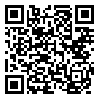Volume 60, Issue 1 (13 2002)
Tehran Univ Med J 2002, 60(1): 19-24 |
Back to browse issues page
Download citation:
BibTeX | RIS | EndNote | Medlars | ProCite | Reference Manager | RefWorks
Send citation to:



BibTeX | RIS | EndNote | Medlars | ProCite | Reference Manager | RefWorks
Send citation to:
Zafarghandy MR, Nasiri Sheikhani N. Acute Arterial Thromboembolism In The Extremities: A Case Series In Sina General Hospital,1991-97. Tehran Univ Med J 2002; 60 (1) :19-24
URL: http://tumj.tums.ac.ir/article-1-1276-en.html
URL: http://tumj.tums.ac.ir/article-1-1276-en.html
Abstract: (6872 Views)
"Arterial Thromboembolism" is the most common cause of "Acute Arterial Ischemia" of extremities. In this study, It is attempted to collect retrospectively some documentary information of all "acute arterial thromboembolic occlusions of the limbs".
Materials and Methods: In descriptive retrograde study in Sina General hospital, all related records in this regard were collected from March 1991 to March 1997. To reveal the statistical outcomes and analysis the associations between them as well, the statistical tests like nonparametric ones were employed.
Results: Total number of the cases was 24 with " Acute Thromboembolic Arterial limb Ischemia" (3 in upper and 21 in lower limbs). The results were as follows: Female to male ratio =1/2, "Range of Age": 34-91, "Mode"=8th decade of life, "Mean"-64.48, "Etiology" Cardiac Origin in majority of cases ("A.F" in 57 percent) and Unknown Origin in 1/4 of cases. "Pain" was find in 95 percent, Grade HI ischemia in only 38 percent of patients on presentation and the others in Grade n. The most common "site of embolic occlusion" was "Femoral Ar." (76 percent). "Simultaneous Embolic Events" were fined in 29 percent. "Embolectomy" was performed in 79 percent (84 percent success rate) and "Primary Amputation" in 12.5 percent. "In hospital Mortality Rate" was fined in 24 percent and "Limb Salvage rate" in 68 percent. In conclusion, there were some logic relationship only between "Limb Salvage rate" and "Ischemic Grading" and also "Delayed diagnosis". There was also some significant direct relationship between "Mortality rate" and "Concomitant Embolic events".
Conclusion: This study was an explorative one that paves the way for further complementary investigations. Although there are many recommendations due to upgrading knowledge, attitude and practice of physicians as well as lay people Besides, the upgrading of educational and curative facilities should not be neglected.
Materials and Methods: In descriptive retrograde study in Sina General hospital, all related records in this regard were collected from March 1991 to March 1997. To reveal the statistical outcomes and analysis the associations between them as well, the statistical tests like nonparametric ones were employed.
Results: Total number of the cases was 24 with " Acute Thromboembolic Arterial limb Ischemia" (3 in upper and 21 in lower limbs). The results were as follows: Female to male ratio =1/2, "Range of Age": 34-91, "Mode"=8th decade of life, "Mean"-64.48, "Etiology" Cardiac Origin in majority of cases ("A.F" in 57 percent) and Unknown Origin in 1/4 of cases. "Pain" was find in 95 percent, Grade HI ischemia in only 38 percent of patients on presentation and the others in Grade n. The most common "site of embolic occlusion" was "Femoral Ar." (76 percent). "Simultaneous Embolic Events" were fined in 29 percent. "Embolectomy" was performed in 79 percent (84 percent success rate) and "Primary Amputation" in 12.5 percent. "In hospital Mortality Rate" was fined in 24 percent and "Limb Salvage rate" in 68 percent. In conclusion, there were some logic relationship only between "Limb Salvage rate" and "Ischemic Grading" and also "Delayed diagnosis". There was also some significant direct relationship between "Mortality rate" and "Concomitant Embolic events".
Conclusion: This study was an explorative one that paves the way for further complementary investigations. Although there are many recommendations due to upgrading knowledge, attitude and practice of physicians as well as lay people Besides, the upgrading of educational and curative facilities should not be neglected.
| Rights and permissions | |
 |
This work is licensed under a Creative Commons Attribution-NonCommercial 4.0 International License. |





